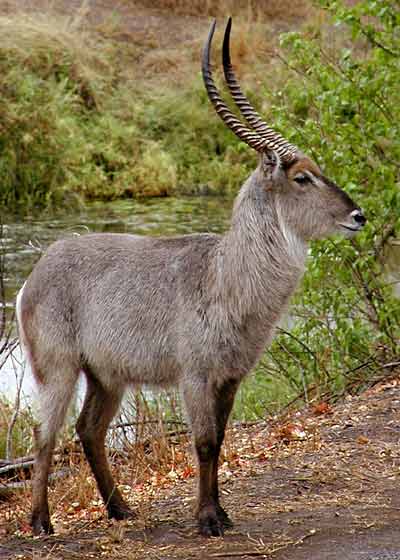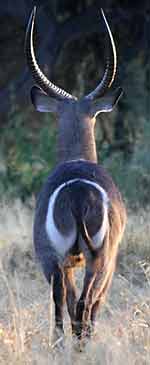Contact Details: Scotch Macaskill, Dirt Road Traders, Currys Post Road, Howick, KwaZulu-Natal, South Africa. Tel: +27 (0)82 578 2329. Privacy: Your privacy is guaranteed. See our Privacy Policy for more. This site accepts advertising and other forms of compensation - see Disclosure and Advertising for details. Site updated: 2022. Copyright © 2002 - 2022 Scotch Macaskill

| ||||||||||
|
||||||||||
|
SEE ALL
|
The Ruggedly Handsome Waterbuckby Roddy SmithRobert Ruark once wrote that there is no more ruggedly handsome animal in Africa than the male waterbuck. He is not as showy as the kudu or sable; by comparison with them his shaggy coat is rather plain and his horns workmanlike rather than spectacular, but with his sturdy build, proud stance and unique gait he is an imposing sight. Unlike impala and kudu which either walk or run, the waterbuck favours a high trot that would be the envy of many a dressage trainer.
This white ring is one of the most prominent examples of what are known as "follow me" markings in mammals. These are markings which make it easy for animals of the same species to follow each other, and particularly for young animals to follow mothers running from danger. Limited Colour Vision
Because most mammals have limited if any colour vision, these markings are usually black or white, depending which contrasts most with the animals' over-all colouring. Some are permanently visible, while others are only displayed when they are needed. The waterbuck's white ring is always there, as is the impala's "Macdonald's" marking – the black stripes on each side of the rump and on the tail. Kudu on the other hand only show their “follow-me” markings when they run; they curl up their tails and fan them out to show the white underlayer of hair. Warthogs don't have contrasting colours; instead they stick their tufted tails straight up in the air to be followed, rather like the raised umbrellas of Japanese tour guides. Predators also have "follow-me" markings: the black marks on the backs of a lion's ears, the highest part of the body,
contrast with the generally light body colour and that of the surroundings and make it easier for cubs to follow their mother in tall grass.
Leopards have a white tip to the underside of the tail which shows when it is curled up; this shows up better in contrast to the generally darker colour of the leopard and the shadowy undergrowth it often frequents. Dependent on Water Waterbuck are even more dependent on water than domestic cattle, but they don't actually spend that much time in it. Although they swim well and will freely cross water or run into it to escape predators, they prefer to be on dry land and are much less aquatic than sitatunga or lechwe. Their skin exudes a greasy smelly subtance into the shaggy coat that is believed to help waterproofing. It is also believed to taint the flesh, as does the fat, and certainly waterbuck meat is not pleasant to human taste, but the widespread belief that it makes them unattractive to predators is another popular myth. In fact in the Kruger Park lions kill more waterbuck in proportion to their overall numbers than most other antelope. Waterbuck tend to be very sedentary, and although they are gregarious animals appear to be more attached to their home range than to the group. "Herds" are so amorphous and changing in composition that they seem almost to be more an association of individuals living in the same area than a homogenous group. On the other hand outsiders are not tolerated, and there often appears to be a creche system in operation, where five or six young ones will be left together with a single adult female or by themselves. Babies Left in Hiding The females isolate in thickets to give birth, apparently preferring to use the same location each time. Babies are left in hiding for three to four weeks, and the mother returns three or four times a day to suckle them for about five minutes and then cleans them to remove any smell which could betray them to predators . They are weaned at about nine months (although they can graze well before that) and thereafter are more or less on their own. Males are sexually mature at three, but remain in bachelor herds and only start competing for territories at about six. Fighting can be more serious than in many other antelope species and not infrequently results in death. Having established a territory, most males seem to tolerate bachelor herds as long as they behave themselves, but this is not always the case; some are more fiercely possessive than others. The career of a territorial male is not long and is generally over by the age of 10, after which they remain solitary and generally in the same place. I know a number of old males on the Zambezi who never move more than a couple of hundred metres. Unkind people have suggested that I have much in common with them. Roddy Smith is a wildlife conservationist and safari guide based in the Lower Zambezi National Park, Zambia. Images © Scotch Macaskill Return to Wildlife Articles |
|||||||||
|
|
||||||||||


